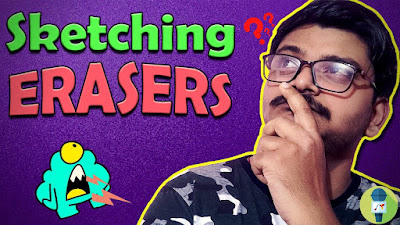Eraser and its importance
Theoretically,
Erasers are just tools to rub anything (to erase something, it's called Eraser). Well, having the problem in understanding, have a look at the below example.
Reena
is attending her drawing class. The children in the class were asked to draw a
tourist bus carrying people. While drawing Reena makes a car instead of a
tourist bus. She checks her box and couldn’t find anything. Finally, she
borrows an eraser from her friend and rubs (erases) her drawing, and corrects
her mistake.
The above example clearly depicts the importance of having tools to correct oneself
mistake in life. However, when it comes to sketching (a form of art and crafts)
one cannot use just a common rubber. Hence, we list out the following
categories of erasers to sort out your problems.
Different Categories of Erasers
- Vinyl Eraser (or Normal Pencil Eraser)
These are the daily use of normal erasers. Often referred to as “plastic erasers” or “drafting erasers”. These erasers are quite hard and are made to perform daily normal uses. With the example above, Reena uses a vinyl eraser. They are cheaply available and very durable. Their clean and complete erasing capabilities make them the favored type for drafters. However, if used too harshly, they can damage the paper of sketching.
- Kneaded Eraser
Also known as “Kneaded rubber”. These can be molded in almost any shape just like stiff clay. It has a very unique working approach. It picks up the pigment off of the paper and doesn’t leave crumbs. It can be re-kneaded to absorb graphite.
As the kneaded erasers can be re-shaped to the need, they can be used to erase different areas. They can be used to erase areas of very fine details as well as large surface areas. However, when used for longer time intervals the rubber can become sticky and cause damage to sketching. So, they are unpreferable for large surface areas erasing.
- Pencil Eraser
The pencil-like structure with a smooth ending is what defines a Pencil Eraser. Very commonly referred to as “erasil”. The pencil eraser looks like a pencil, but instead of graphite, it has a vinyl eraser tip. It can be used to erase very specific areas and can even be sharpened to a point. However, the firm tip and point can make it harsh on paper, so this should only be used on small details.
- Mechanical Eraser
Most of you may have come across the term “mechanical eraser” in sketching. Ever wondered why they are so-called? Let us explore:
The mechanical erasers derive their name from their “design”. They are designed to work with 2 AAA-size battery and a button. When the button is switched on the needle of the pencil rotates. Having a needle with a small surface area is the best choice for artisans sketching “minutely”. But lesser cross-section area restricts its use in larger sketch erasing. These are pieces of advice, only for professionals and beginners should keep their eye away from this.
Conclusion
Well,
it really depends on a person’s sketching skills and needs to decide which
erasers they should use. As far as choices are concerned, views on a particular
topic make a call on the category of eraser. For example, if someone wants to
glorify a cheerful moment, and needs minute changes can go for mechanical
erasers. While one sketching for multiple events must use kneaded erasers.
Finally, we hope we had answered all your doubts regarding usage. All the best and may you succeed in your sketching.
















0 Comments